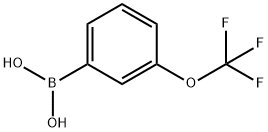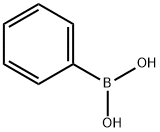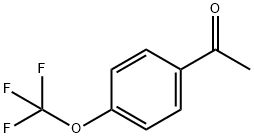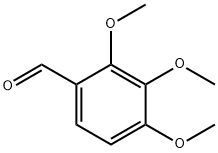3-Trifluoromethoxyphenylboronic acid
Synonym(s):3-Trifluoromethoxybenzeneboronic acid
- CAS NO.:179113-90-7
- Empirical Formula: C7H6BF3O3
- Molecular Weight: 205.93
- MDL number: MFCD01320697
- EINECS: 642-464-2
- SAFETY DATA SHEET (SDS)
- Update Date: 2023-04-23 13:52:06

What is 3-Trifluoromethoxyphenylboronic acid?
Chemical properties
almost white to slightly beige powder and chunk
The Uses of 3-Trifluoromethoxyphenylboronic acid
3-(Trifluoromethyloxy)phenylboronic Acid is used as a reagent in the preparation of pyrrolo[1,2-a]pyrazinones as inhibitors of PIM kinases.
The Uses of 3-Trifluoromethoxyphenylboronic acid
Precursor commonly used in the synthesis of biologically active compounds including:
- Multisubstituted purines for use as P2X7 antagonists in the treatment of pain
- Heteroaryl substituted tetrahydropyrroloijquinolinone derivatives as aldosterone synthase inhibitors
- Fluorohydroquinolineethanol as a CETP inhibitor
- Biaryl amides with muscarinic acetylcholine receptor subtype M1 agonist activity
- C2-aryl pyrrolobenzodiasepine antitumor agents
- Piperazine-bisamide for obesity treatments
The Uses of 3-Trifluoromethoxyphenylboronic acid
suzuki reaction
Properties of 3-Trifluoromethoxyphenylboronic acid
| Melting point: | 84-89 °C (lit.) |
| Boiling point: | 266.6±50.0 °C(Predicted) |
| Density | 1.41±0.1 g/cm3(Predicted) |
| storage temp. | Keep in dark place,Sealed in dry,Room Temperature |
| form | Powder and Chunks |
| pka | 7.39±0.10(Predicted) |
| color | Almost white to slightly beige |
| BRN | 7531456 |
| CAS DataBase Reference | 179113-90-7(CAS DataBase Reference) |
Safety information for 3-Trifluoromethoxyphenylboronic acid
| Signal word | Warning |
| Pictogram(s) |
 Exclamation Mark Irritant GHS07 |
| GHS Hazard Statements |
H315:Skin corrosion/irritation H319:Serious eye damage/eye irritation H335:Specific target organ toxicity, single exposure;Respiratory tract irritation |
| Precautionary Statement Codes |
P261:Avoid breathing dust/fume/gas/mist/vapours/spray. P264:Wash hands thoroughly after handling. P264:Wash skin thouroughly after handling. P280:Wear protective gloves/protective clothing/eye protection/face protection. P304+P340:IF INHALED: Remove victim to fresh air and Keep at rest in a position comfortable for breathing. P305+P351+P338:IF IN EYES: Rinse cautiously with water for several minutes. Remove contact lenses, if present and easy to do. Continuerinsing. P405:Store locked up. |
Computed Descriptors for 3-Trifluoromethoxyphenylboronic acid
New Products
4-Fluorophenylacetic acid 4-Methylphenylacetic acid N-Boc-D-alaninol N-BOC-D/L-ALANINOL Tert-butyl bis(2-chloroethyl)carbamate 3-Morpholino-1-(4-nitrophenyl)-5,6-dihydropyridin- 2(1H)-one Furan-2,5-Dicarboxylic Acid Tropic acid S-2-CHLORO PROPIONIC ACID ETHYL ISOCYANOACETATE 2-Bromo-1,3-Bis(Dimethylamino)Trimethinium Hexafluorophosphate (6-METHYL-[1,3]DITHIOLO[4,5-b]QUINOXALIN-2-ONE INDAZOLE-3-CARBOXYLIC ACID 4-IODO BENZOIC ACID (2-Hydroxyphenyl)acetonitrile 4-Bromopyrazole 5,6-Dimethoxyindanone 2-(Cyanocyclohexyl)acetic acid 4-methoxy-3,5-dinitropyridine 2-aminopropyl benzoate hydrochloride 1-(4-(aminomethyl)benzyl)urea hydrochloride diethyl 2-(2-((tertbutoxycarbonyl)amino) ethyl)malonate tert-butyl 4- (ureidomethyl)benzylcarbamate Ethyl-2-chloro((4-methoxyphenyl)hydrazono)acetateRelated products of tetrahydrofuran








You may like
-
 3-(Trifluoromethoxy)phenylboronic Acid (contains varying amounts of Anhydride) CAS 179113-90-7View Details
3-(Trifluoromethoxy)phenylboronic Acid (contains varying amounts of Anhydride) CAS 179113-90-7View Details
179113-90-7 -
 3-(Trifluoromethoxy)benzeneboronic acid CAS 179113-90-7View Details
3-(Trifluoromethoxy)benzeneboronic acid CAS 179113-90-7View Details
179113-90-7 -
 1975-50-4 98%View Details
1975-50-4 98%View Details
1975-50-4 -
 2-HYDROXY BENZYL ALCOHOL 98%View Details
2-HYDROXY BENZYL ALCOHOL 98%View Details
90-01-7 -
 2-Chloro-1,3-Bis(Dimethylamino)Trimethinium Hexafluorophosphate 221615-75-4 98%View Details
2-Chloro-1,3-Bis(Dimethylamino)Trimethinium Hexafluorophosphate 221615-75-4 98%View Details
221615-75-4 -
 61397-56-6 CIS BROMO BENZOATE 98%View Details
61397-56-6 CIS BROMO BENZOATE 98%View Details
61397-56-6 -
 14714-50-2 (2-Hydroxyphenyl)acetonitrile 98+View Details
14714-50-2 (2-Hydroxyphenyl)acetonitrile 98+View Details
14714-50-2 -
 118753-70-1 98+View Details
118753-70-1 98+View Details
118753-70-1
Statement: All products displayed on this website are only used for non medical purposes such as industrial applications or scientific research, and cannot be used for clinical diagnosis or treatment of humans or animals. They are not medicinal or edible.